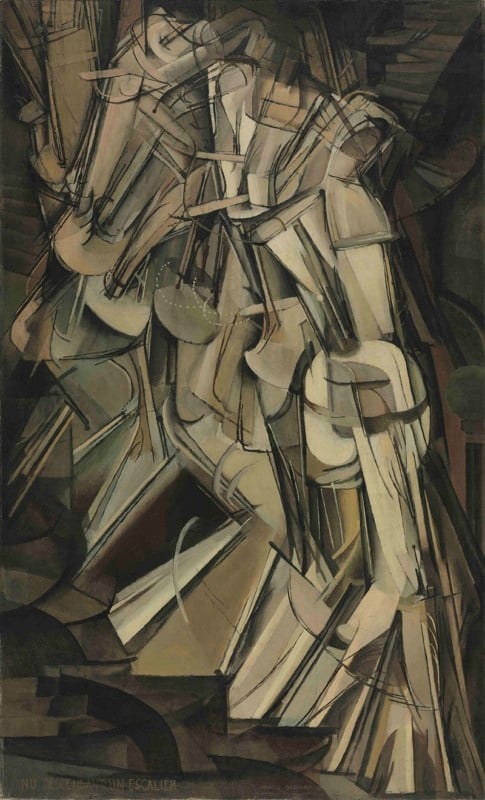Nude Descending a Staircase, N0 2. The 1912 painting by Marcel Duchamp is what started me on my exploratory journey into cubist photography. I thought to recreate it with a long exposure and multiple bursts of flash. But I don’t know anyone with a long open staircase nor anyone willing to model naked on a public staircase.

The painting did, however, spark an interest for me in the cubist painters of 100 years ago. Duchamp, Georges Braque, Fernand Leger and, of course, Pablo Picasso and others.
Throughout history, painters have struggled to create the feeling and appearance of depth on the two-dimensional canvas medium. Cubism dispensed with that idea by depicting space as supported by the flatness of the canvas. A cubist work depicts the subject as viewed from several vantage points simultaneously. This is usually represented by the subject being composed of several different planes.
As photographers we struggle with the same limitations, trying to create depth by lens choice, perspective, and inclusion of foreground while also being limited to 2 dimensions. Could there be a way to use the limitations in the same way painters did and emphasize the flatness of the ‘canvas’ rather than try to make a photograph a 3 dimensional as possible? With my creative side and curiosity now fully engaged I asked myself, “Am I on the verge of inventing a new genre of photography?”
Unsurprisingly, no. There’s nothing new under the sun. A quick search revealed that, although not a very common genre, cubist photography is not a complete rarity. It was most famously pioneered by renowned painter David Hockney who experimented in the 1980s with cutting up Polaroid prints and piecing them together in what he called ‘joiners’.
Today as digital photographers we have more advanced technology such a Photoshop, but the process and results are essentially the same.
Further investigation revealed that there are other cubist photographers. As with any photographic genre, there are many takes on the subject. Quite a few cubist photographers create cubist portraits, but there are numerous examples of landscape, architecture, still life, etc.
A painter has the advantage of being able to paint any concept while we photographers are limited to what actually exists in front of the lens. However, this does not limit a photographer from viewing a subject from more than one perspective at a time. In fact, for most subjects, we have the opportunity to walk around and photograph from many different angles and perspectives. We can shoot any combination of wide and tight. Shoot for the broader scene and move in for detail.
My own journey began with architecture/street scenes. Buildings allow you to move around and work the scene. I usually begin a piece by making an approach shot of a building. I like to include the street and sidewalk. I then walk to either side, left and right, and shoot the approaches from there. Shooting from ground level up to about as high as I can gives me a lot of perspective to work with. I move or zoom in to add some details. Sometimes cars or pedestrians work into the scene quite well. I take a lot of shots, 40 or more so I have a lot of choices for inclusion in the final work.
![]()
It’s when I get in front of the computer that the real fun begins. In Photoshop I start by creating a blank page the size that I’d like the final piece to be. Then I open individual photographs that I think will work in the picture and size them to fit. In art, there are no rules, but I generally like to place elements about where they actually are in the live scene.
![]()
Photoshop gives a few advantages that painters don’t have access to, layers being the most obvious. I make a lot of use of the transform tools to change the perspective of some elements, warp them, angle them and generally bend the pixels to my will. The use of blend modes, opacity, and color toning can also give some elements a more interesting appearance or visual weight. And I have learned some mad selection skills to use only the pieces I want from each image. I frequently move layers up or down (in front of or behind) to see how the look changes. The result is a multi-layer collage sometimes as many as 80 layers in a piece.
![]()
I have experimented with a few different ideas including a self-portrait, the inside of a C-train, and a piano. I have not successfully made a cubist landscape yet.
![]()
![]()
My body of work continues to grow and still intrigues me. I was recently accepted to exhibit my work at Framed On Fifth in Calgary for the 2022 Exposure Photography Festival which features photography in dozens of venues throughout Calgary and up the Bow Valley to Banff.
![]()
![]()
![]()
![]()
If you are looking for another creative outlet for your photography cubism may be what you’re looking for. Be forewarned. Each piece takes several hours. This is only for the patient and those who enjoy post-processing. I look forward to seeing your work if you should go down this path.
About the author: Byron Robb is a photographer based in Calgary, Canada. The opinions expressed in this article are solely those of the author. You can find more of Robb’s work on Flickr.
